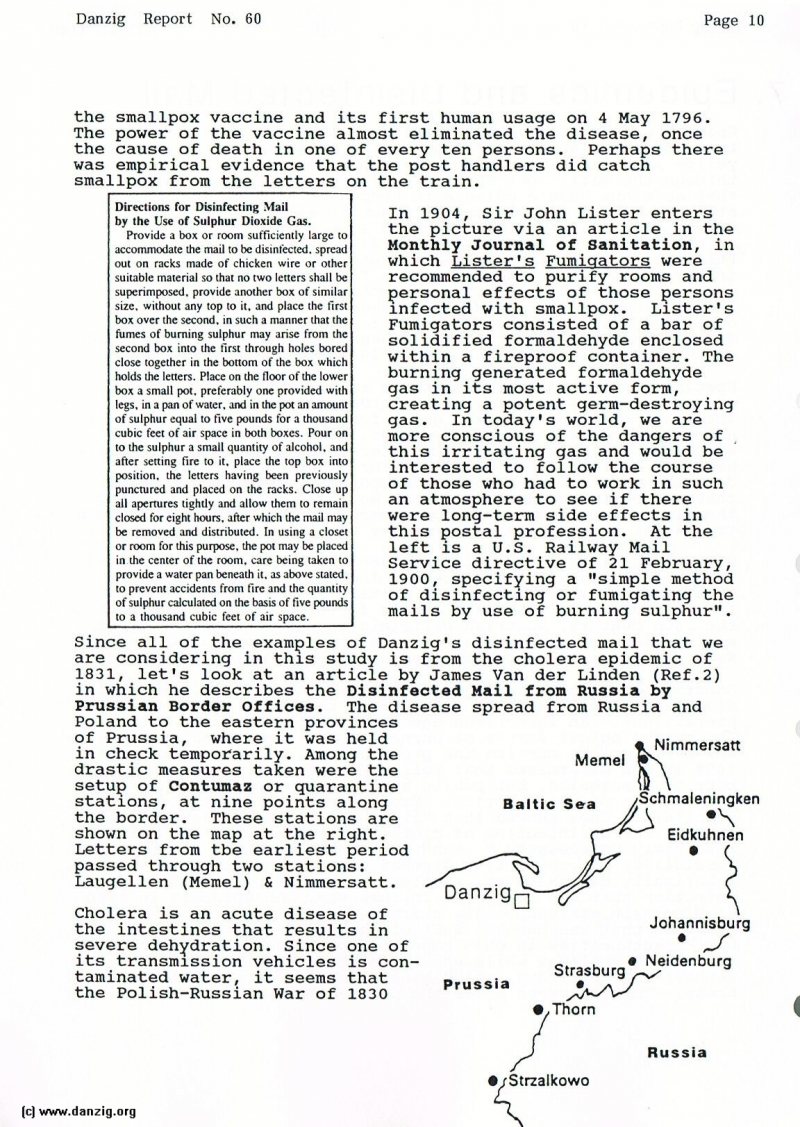
>> 7. Epidemics and Disinfected Mail
the smallpox vaccine and its first human usage on 4 May 1796. The power of the vaccine almost eliminated the disease, once the cause of death in one of every ten persons. Perhaps there was empirical evidence that the post handlers did catch smallpox from the letters on the train.
In 1904, Sir John Lister enters the picture via an article in the Monthly Journal of Sanitation, in which Lister’s Fumigators were recommended to purify rooms and personal effects of those persons infected with smallpox. Lister’s Fumigators consisted of a bar of solidified formaldehyde enclosed within a fireproof container. The burning generated formaldehyde gas in its most active form, creating a potent germ—destroying gas. In today’s world, we are more conscious of the dangers of this irritating gas and would be interested to follow the course of those who had to work in such an atmosphere to see if there were long—term side effects in this postal profession. At the left is a U.S. Railway Mail Service directive of 21 February, 1900, specifying a “simple method of disinfecting or fumigating the mails by use of burning sulphur”.
Since all of the examples of Danzig’s disinfected mail that we are considering in this study is from the cholera epidemic of 1831, let’s look at an article by James Van der Linden (Ref.2) in which he describes the Disinfected Mail from Russia by Prussian Border Offices. The disease spread from Russia and Poland to the eastern provinces of Prussia, where it was held in check temporarily. Among the Memel drastic measures taken were the setup of Contumaz or quarantine stations, at nine points along the border. These stations are shown on the map at the right. Letters from the earliest period passed through two stations: Laugellen (Memel) & Nimmersatt.
Cholera is an acute disease of the intestines that results in severe dehydration. Since one of its transmission vehicles is contaminated water, it seems that the Polish—Russian War of 1830
Directions for Disinfecting Mail
by the Use of Sulphur Dioxide Gas.
Provide a box or room sufficiently large to accommodate the mail to be disinfected. spread out on racks made of chicken wire or other suitable material so hat no two letters shall be superimposed. provide another box of similar size, without any top to it. and place the first box over the second, in such a manner that the fumes of burning sulphur may arise from the second box into the first through holes bored close together in the bottom of the box which holds the letters. Place on the floor of the lower box a small pot, preferably one provided with legs, in a pan of water, and in the pot an amount of sulphur equal to five pounds for a thousand cubic feet of air space in both boxes. Pour on to the sulphur a small quantity of alcohol, and after setting lire to it. place the top box into position. the letters having been previously punctured and placed on the racks. Close up all apertures tightly and allow them to remain closed for eight hours, after which the mail may be removed and distributed. In using a closet or room for this purpose, the pot may be placed in the center of the room, care being taken to provide a waler pan beneath it, as above stated, to prevent accidents from fire and the quantity of sulphur calculated on the basis of five pounds to a thousand cubic feet of air space.
Danzig Report Nr. 60 - July - August - September - 1988, Page 10.
Hits: 3600
Added: 26/06/2015
Copyright: 2025 Danzig.org

